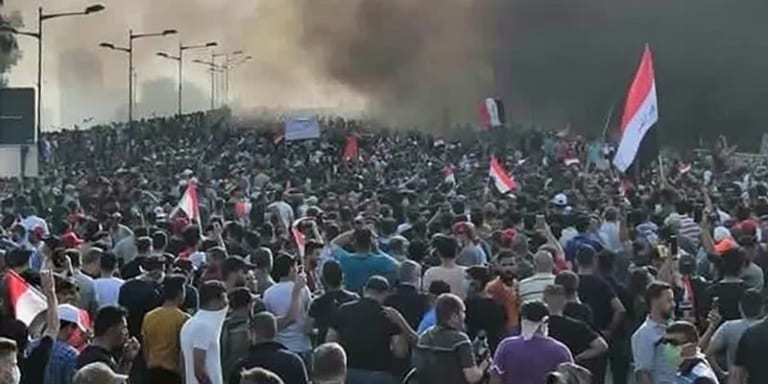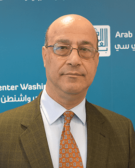
Protests have again rocked Iraq’s streets as thousands of young people voiced their opposition to rampant corruption and sectarian politics. While the demonstrations appeared leaderless and did not seem to espouse a specific program—except generally to demand an end to public sector malfeasance and the provision of public services—they nevertheless showed that the Arab Spring is alive in Baghdad and other Iraqi cities. Whether the protests will lead to desired changes remains unknown; but it is evident that Iraq’s youth may have grown impatient with the government’s neglect of their needs. If anything, Iraq’s protests offer another example of an approaching, painful, and final collapse of the traditional Arab political order that has shown its impotence in addressing the myriad problems besetting Arab societies today.
To be sure, the fact is that those Iraqis taking to the streets are similar to their cohorts in other Arab countries—mostly urban, educated youth dissociated from the political parties and elites that have benefited from dependent capitalism, one supported by state apparatuses of oppression and disenfranchisement. However, Iraq’s young people are also demonstrating against their government’s supine near-surrender to the dictates of Iranian interference in Iraqi affairs and the power of Iran-supported militias. In addition, they are frustrated with the government’s failure to provide essential services and functions to Iraqi society. In Lebanon, the citizens protesting the government are also demanding respect from a state that is not beholden to sectarian leaders and politics. Those in Egypt are challenging the power of military and security services and demanding the departure of President Abdel-Fattah el-Sisi and unaccountability for state repression. In Sudan and Algeria, the street does not appear to have calmed down despite a political arrangement in the former and promises of change in the latter.
Iraq’s protests offer another example of an approaching, painful, and final collapse of the traditional Arab political order that has shown its impotence in addressing the myriad problems besetting Arab societies today.
What was shocking in the Iraqi case was the wanton disregard of human life and basic human rights of peaceful demonstrators. Over five days of protests, 104 Iraqis were killed, including eight security personnel, and over 6,000 were injured. Not even in Egypt, where security services are not loath to respond violently to protests against the government’s failures, did security personnel feel so free to use live ammunition against unarmed protesters over the last few weeks (over 2,300 have been arrested and detained in Egypt.) The severity of the response in Iraq attests to two interlinked and disturbing phenomena that underlie the Iraqi political order.
First is the reality that the besieged Iraqi government, like all others in the Arab world, is unprepared to address grievances through dialogue; assuming that its political factions have full control over the public space. Instead, the government’s initial response was a violent confrontation to force protesters off the streets. It justified its killing of protesters and blamed infiltrators for instigating violence. Although there have been no firm reports that parties other than security forces were responsible for the carnage, it was clear that those with guns wanted to quell the unrest quickly and decisively. No other reason can explain the wanton killing and wounding of peaceful demonstrators, all of whom were demanding redress for their legitimate concerns.
Second is the inescapable fact that those responding to the unrest had no intention of sitting still and allowing what happened a little over a year ago to recur. At that time, throngs of protesters took to the streets to oppose government policies and to register their objection to the outsize influence of Iran-supported militias in the south and in the political system. The protesters dared to attack and set on fire the offices of these militias and associated parties, actions that challenged their dominance over the communities and over local decision-making. Perhaps most shocking for the authorities, then and now, was that the “Shia street” moved against what is practically a Shia-dominated political order, one sustained by deals and compromises among Shia politicians themselves. Additionally, the protests have sent a wrong message regarding Iranian prestige at a time the Islamic Republic is trying to rally its troops and affiliated militias in a serious confrontation with the United States and its Arab allies in the Gulf.
The protests have sent a wrong message regarding Iranian prestige at a time the Islamic Republic is trying to rally its troops and affiliated militias in a serious confrontation with the United States and its Arab allies in the Gulf.
Like all other governments in the region and elsewhere when they are confronted by widespread demonstrations, Prime Minister Adel Abdel-Mahdi’s cabinet promised a series of reforms that, in reality, may not address the deep socioeconomic troubles afflicting the country. It is also unlikely that a cabinet reshuffle would succeed in addressing the socioeconomic ills at the heart of the protests; instead, it would probably be an exercise of musical chairs in Baghdad. The same conditions caused the unrest of 2018 that resulted in the loss of confidence in former Prime Minister Haider al-Abadi’s government and his replacement with Abdel-Mahdi. Indeed, not much has changed in the way Iraqi politics is conducted or in how the economic pie is distributed.
Corruption is still as rampant as it was in 2018 when Iraq ranked 168 out of 180 countries on Transparency International’s corruption perception index, a rank that has barely changed since 2015. The unemployment rate among young people is 22 percent, with the government admitting that it has made no plans for the large numbers entering the job market every year. Iraqi President Barham Saleh admitted that 300,000 college graduates cannot find jobs—and this is in a country that boasts massive hydrocarbon reserves and revenues sufficient for a major development drive that could gainfully employ hundreds of thousands of skilled and unskilled workers. Politically, the Iran-affiliated militias of the Popular Mobilization Forces (PMF) appear to increase their sway over segments of the Iraqi street and state, despite Premier Abdel-Mahdi’s order to place the PMF fully under government authority. To be sure, it is hard to see how such militias––which are similar in ideology and composition to Lebanon’s Hezbollah––could be pressed to be loyal only to Iraqi sovereignty and decision-making.
Indeed, the dejection of Iraqi society that has resulted from the government’s failure to build a functioning state—one that is beholden neither to sectarian interests nor to Iran—may lead to widening dissatisfaction. This may help change the Iraqi political order in the foreseeable future. While the mass, leaderless protests offered no specific program to chart the contours of required change, the sentiments leading to the protests are practically indistinguishable from the stirrings of similar movements in other countries, the latest of which were in Egypt and Lebanon. In other words, the winds of the Arab Spring still blow, ever so faintly, to remind the traditional Arab order that needed change cannot continually be relegated to empty promises that decision-makers know will not address the many longstanding ills created by their policies.

